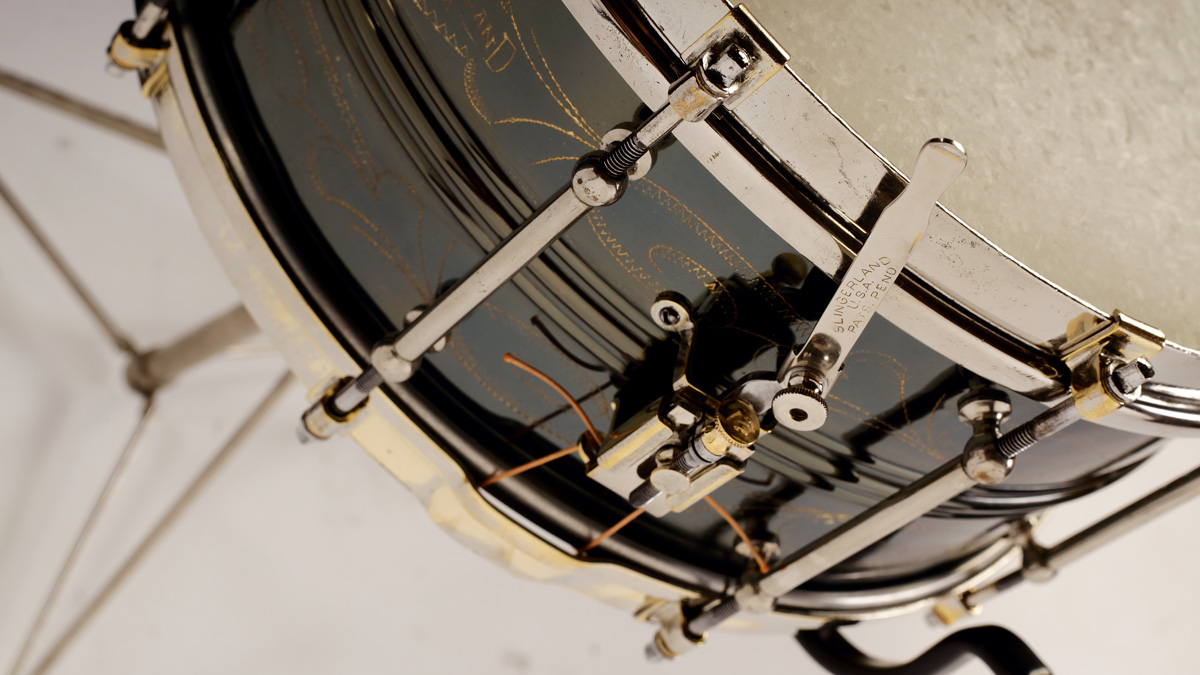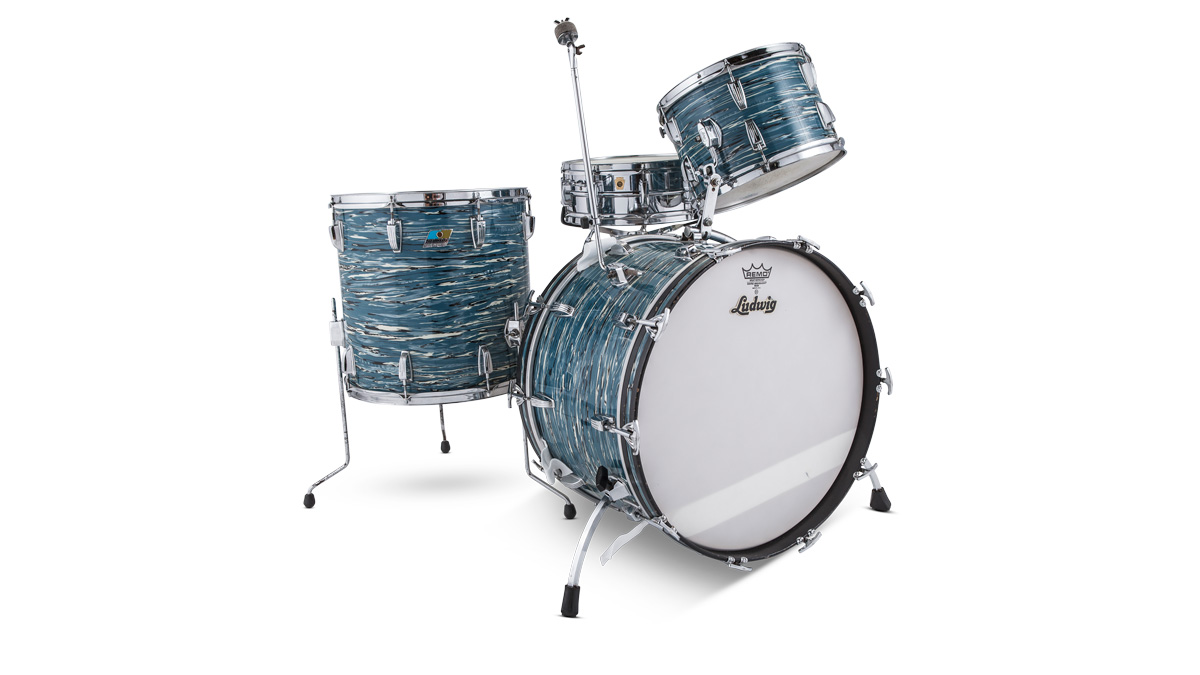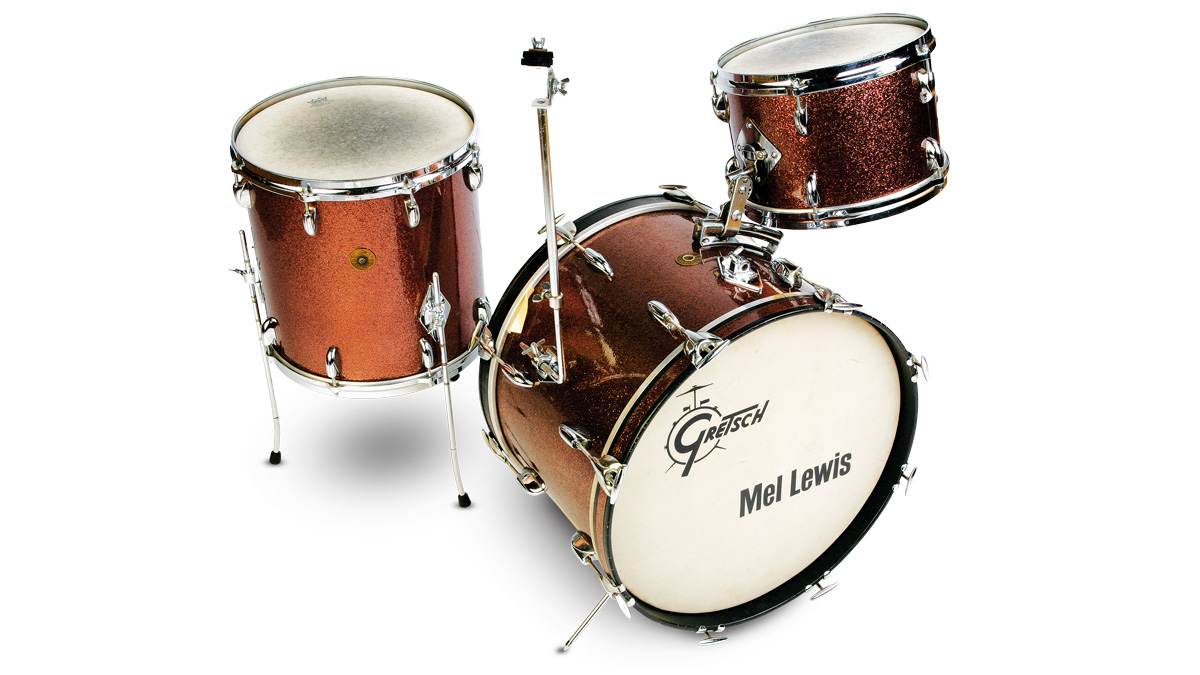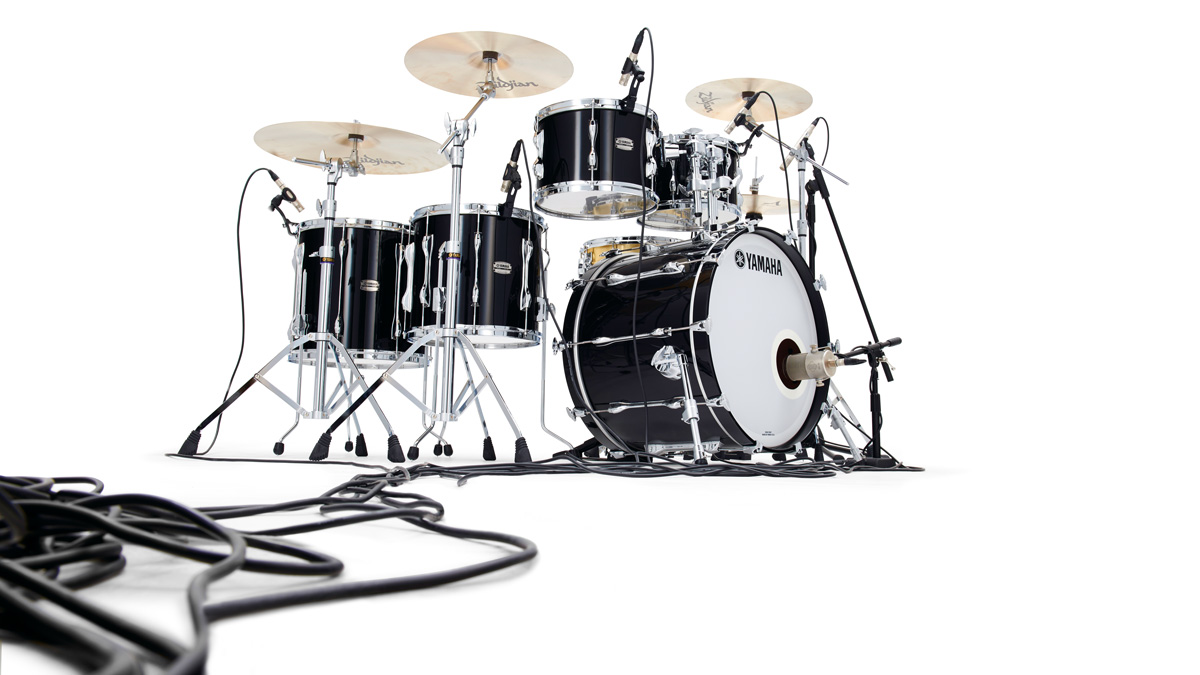The historic gear that transformed drumming forever
The real game changers

1. Ludwig and Ludwig 1909 Pedal
In just over 100 years the drum kit has evolved from the individual components of the marching band and theatre pit orchestra to the sleek and gleaming products of today’s international drum industry.
Here we count down 10 game-changing steps in that evolution, starting with Ludwig and Ludwig’s 1909 pedal.
Before the sit-down drum kit as we know it could really get going a few things needed to happen. Like Ulysses Grant Leedy needed to construct the first snare drum stand, which he did around 1898.
The biggie though was placing the bass drum on the floor and walloping it with the foot. That required a pedal, and many unwieldy contraptions preceded the Ludwig pedal seen here.
Brothers William and Theobald Ludwig marketed their first pedal in 1909, thereby launching their illustrious company in Chicago.
You may shake your head in disbelief there at the back, but the truth is the Ludwigs’ pedal took off because it was clamped to the bottom hoop (not slung from the top), it was pocket-sized and collapsible for easy transport. Plus crucially it had a spring return mechanism which enabled the beater to respond swiftly to the drummer’s nippy ragtime beat.
Everyone wanted one and the Jazz Age was off and running. Although flimsy by modern standards, the fundamentals of the Ludwig design have stood the test of time. With its elevated shaft and cam-action beater rod, adjusted for feel by a side mounted expansion spring, it has much in common with today’s bulkier pedals.

2. Slingerland Black Beauty
Although drum kits are nearly all made from wood, the snare drum is just as often made from metal.
Early snare drums had wood shells and wood hoops. But William Ludwig (again) was impressed by a German-made (likely Sonor) metal shell side drum he saw played in the band of famed marching band maestro John Philip Sousa (who was all the rage back then). So Ludwig went into making metal shell drums by 1911, soon after the success of its bass pedal.
Ludwig’s engineer Robert Danly also came up with the first decent throw-off/strainer in 1919, a side-lever design which is still going strong! All the big American companies made brass snare drums and early examples were often nickel or chrome plated. Some though were finished in black-nickel-over-brass and for a bit extra you could get one hand-engraved with intricate patterns (it was that sort of fussy, decorative age).
The black-on-brass drums became known as Black Beauties and have achieved legendary status. Ludwig Black Beauty snares are still marketed in 2017, although actually Slingerland was first to coin the Black Beauty description back around 1928, so Black Beauty is something of a generic term.

3. Ludwig Super Classic
Ludwig’s standard four-piece kit of 22"x14", 13"x9", 16"x16" with 14"x5" metal shelled Supraphonic 400 snare drum was the star of the rock era.
Gretsch, Rogers and Slingerland were also big players, but once Ringo Starr appeared on the Ed Sullivan TV show in 1964 with his Oyster Black Ludwig (albeit at first a smaller Downbeat 20, 12, 14 and with the ‘wrong’ Jazz Festival snare drum) Ludwig’s fortune was assured.
Back home, virtually every drummer in the UK dreamed of playing a Ludwig, and in their hordes they spurned their Premiers (Keith Moon being the honourable exception). Thus the UK’s most celebrated drummers, headed up by the likes of Ginger Baker, Mitch Mitchell, John Bonham and Ian Paice, made Ludwig a household name.
The irony is that in many respects UK-made drums, especially those of Premier, but also those of Ajax, Carlton (later, Hayman) and Beverley, were arguably as good as much American product. But coming out of post-war austerity, the UK designs looked dated and were tainted with a Phoenix Nights social club and old fashioned dance band image. Ludwig’s Super Classic, with the 400 snare often touted as the most recorded drum in history, was simply the coolest.

4. Slingerland Radio King drumset
Drum kits prior to the Radio King are historic artefacts, museum pieces, of practical use only to recreate period music which sounds desperately quaint today.
Up until the mid-1930s, drum kits were as likely to be seen accompanying knockabout vaudeville acts as driving early jazz and dance music. Playing the drum kit was an extension of the all-round percussionist’s craft - with klaxons, temple blocks and dog barks - even the cymbals and Chinese toms were more for effect than for groove.
Then it all changed. Following the rise of talkie movies and the universal spread of radio the Swing Era of the great dance bands arrived along with Gene Krupa.
Krupa was the Elvis Presley of Swing, the charismatic white cat who stole the thunder from the pioneering black artists, popularised drumming and introduced the modern drumset.
Krupa dumped the sound effects, insisted on double-headed, tuneable tom toms and played an outrageously swinging hi-hat. When Ludwig passed on him, his dad went to the erstwhile banjo company Slingerland, which seized the opportunity. Slingerland did Krupa proud with the Radio King outfit. It’s the precursor to the instrument we all play today, we’d argue the greatest American invention of the 20th Century!

5. Remo Weatherking
Throughout history drum skins were made from real animal hides/pelts. It’s a little-discussed fact that the rock explosion of the 1960s would have been severely hampered were it not for the plastic drum head.
This relatively cheap innovation enabled harder playing and the unprecedented spread of the amateur popular drummer.
Experiments with synthetic heads had been tried as early as the 19th Century, but as is often the case, it took the technological impetus afforded by war to make the concept a reality.
A polyester film called Mylar, developed by DuPont to replace cracking cellophane movie film used on WWII reconnaissance flights, turned out to have many post-war uses. Jim Irwin spotted the possibility and produced a synthetic head for Duke Ellington’s drummer Sonny Greer in 1953.
However, it was not till 1956 that Marion ‘Chick’ Evans started to make real progress with a viable product. Then the following summer Remo with his Weatherking plastic head stole the lead. Enlisting industrial chemist Sam Muchnik the pair devised and patented a way of moulding and crimping the Mylar, setting it in an aluminium hoop, bonded with epoxy resin. Remo quickly established the market supremacy that the company has held ever since.
Amazingly, the Remo 20" logo bass head from Ringo’s Ludwig kit when The Beatles debuted on The Ed Sullivan Show in 1964 was auctioned in 2015 for over $2.1 million!

6. K Zildjian and Avedis Zildjian bell bronze cymbals
The jazz and later rock development of the modern cymbal is thanks to the Turkish K (until the Istanbul factory was closed around 1977) and the American Avedis Zildjians from 1929.
In the early days of the drum kit cymbals were small and used as novelty effects for punctuation. Then from the mid-1920s drummers began to play a lighter swing rhythm on the newly invented hi-hats. And through the 1930s the jazz ‘ten-to-ten’ rhythm was often moved to the top cymbal which became known as the ride.
The best early cymbals were ‘K’ (Kerope) Zildjians from Istanbul, Turkey. The Zildjian company had famously been founded in Constantinople (now Istanbul) in 1623. Due to the complexity of carrying on the hereditary line, the Zildjian family ‘secret’ formulation passed to Avedis Zildjian III who had emigrated to the USA. Thus in 1929 Avedis Zildjian established a factory in Quincy, Massachusetts.
With the pioneering jazz drummers on his doorstep, Avedis Zildjian began to make larger-diameter cymbals and experimented with different weights and increased quality control. Original K Zildjians were still emanating from Istanbul though, right up till 1977 when the American Zildjians acquired all name rights and closed down the Turkish factory.

7. Gretsch Round Badge drums
If Slingerland’s Radio King embodied the swing band era, Gretsch personified the next great movement in jazz - small group bebop.
While Radio Kings served the deep jungle toms of Krupa, the controlled sound of smaller-sized Gretsch Broadkasters fitted the bill from the 1940s on.
Gretsch was actually founded in 1883, and like Slingerland made other instruments besides drums. But, being based in Brooklyn, Gretsch was close to the action when bop and modern jazz came along. Gretsch had been the first to build lightweight, straight-sided shells with staggered seams for strength. All the other companies employed reinforcing rings back then.
Once the hefty die-cast hoops were added, ‘That Great Gretsch Sound’ was born - a sound not just for jazz, but prized by recording drummers of all styles, right up to today. Bebop often employed lightning fast tempos, again suggesting smaller, tighter drums, which coincidentally were easier to schlep around the small, crowded basement jazz clubs.
So Gretsch was responsible for yet one more step into the modern era. Instead of the 26" or even 28" bass drums of early jazz, Gretsch made the first 20"x14". Finally, even an 18"x12" for Roy Haynes to slip into his sports car’s trunk!

8. Zickos Acrylic drums
The ’60s social revolution in fashions extended to a craze for synthetic materials which seemed ultra-hip at the time.
Plastic drum heads took over from skins and for a while synthetic-shelled drums of fibreglass and Acrylic/Plexiglas (Perspex in the UK) were popular.
The single-minded Ginger Baker actually made his own set of Perspex drums in the mid-1960s, so the idea was evidently abroad. Ludwig would capitalise yet again on the trend with its colourful Vistalites, particularly once John Bonham was seen playing his Amber set. Yet as it happens the first commercial effort was made by another smaller company, Zickos.
American big band drummer Bill Zickos, who owned a music store in Kansas City, experimented with plastic drums in the late 1950s. But it was 1969 before Ron Bushy of early heavy metal band Iron Butterfly caused a stir playing Zickos’s drums, the first commercially available Acrylic set.
Zickos patented his Acrylic drums design in 1970 and they were extremely well-made drums. Almost all other companies produced Acrylic/Plexiglas drums in small quantities. But the fashion died in the later 1970s, hastened by the Middle East oil embargo which caused petroleum-based plastics to escalate in cost.

9. Paiste Giant Beat and 2002 cymbals
Like American drums, good cymbals were hard to come by in the UK and Europe in the 1960s.
Import restrictions meant American Avedis and Turkish K Zildjians were rare and expensive. In 1967, the Swiss company Paiste came to the rescue with its Giant Beat pro line, exploiting a gap in the market for cymbals that could cut through amplified guitars (few drummers were properly miked up).
Paiste used a low tin-content bronze alloy labelled B8 (CuSn8), with eight percent tin rather than the 20 percent of Zildjian’s bell bronze. Rock drummers lapped them up, from Bonham to Copeland. They were replaced in 1971 by the 2002 series which is still popular today.
For years B8 cymbals were labelled with the somewhat derisive description ‘sheet’ metal as opposed to ‘cast’, the implication being that B8 cymbals were ‘pie-sliced’ from sheets of rolled bronze while B20 cymbals were individually crafted from single blobs. Eventually though the budget possibilities of B8 cymbals and their consequent success, particularly with student rockers, meant Zildjian and Sabian both introduced B8 lines.

10. Yamaha Recording Custom 9000 series
Pearl, Tama and Yamaha took the drum world by storm in the late 1970s, decimating the Western drum companies.
Great historic names disappeared. It would take a new company - DW - eventually to revive American fortunes, while it was decades before Ludwig and Gretsch began to claw back some of their previous acclaim.
The Japanese brought about a massive change in drummers’ attitudes towards their gear. Before Yamaha’s RC 9000 few drummers had the foggiest idea what wood their drums were made from. Really! In a masterstroke of marketing chutzpah, Yamaha declared the 9000 to be the first drums made from 100 percent birch, henceforth known as the ‘recording’ wood.
It was as though the scales were lifted from our eyes. Throughout the 1980s everyone turned to birch. The fact that decades of definitive recordings had been cut on American drums made from mahogany or maple seemed to pass us by!
It helped that Steve Gadd - who simultaneously elevated the benchmark for studio drumming - played 9000s. But the 9000 also introduced the first piano-lacquered drums (cross-pollinated from Yamaha’s pianos), which everyone else also copied. Plus, flush bracing lugs (actually a Premier innovation) and superb system hardware. The manufacture of drums entered a new age.

Geoff Nicholls is a musician, journalist, author and lecturer based in London. He co-wrote, co-presented and played drums on both series of ‘Rockschool’ for BBC2 in the 1980s. Before that he was a member of original bands signed by Decca, RCA, EMI and more. ‘Rockschool’ led to a parallel career writing articles for many publications, from the Guardian to Mojo, but most notably Rhythm magazine, for which he was the longest serving and most diverse contributor.